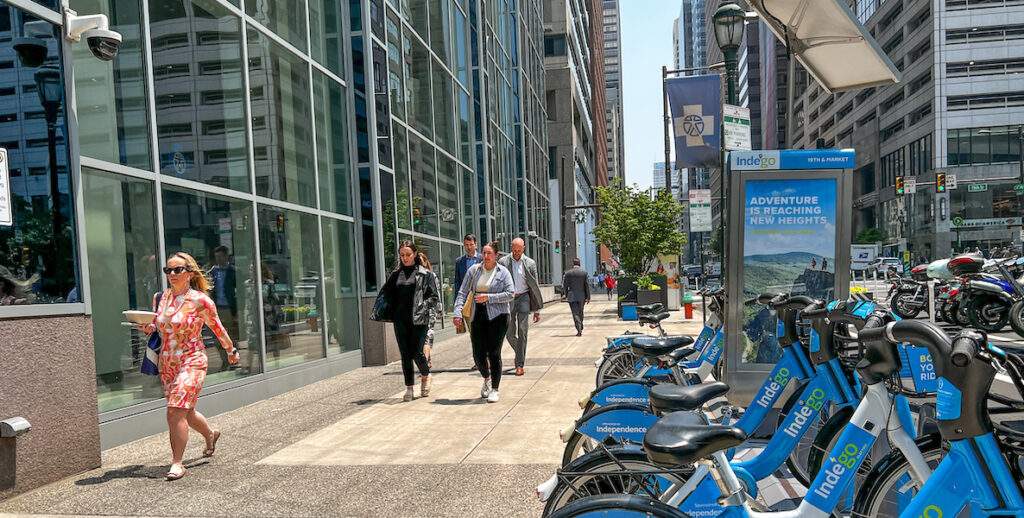Earlier this month, The Philadelphia Inquirer published an interview with two New York professors claiming Philadelphia was lagging in the conversion of office buildings to residential. And just last week, the Wall Street Journal quoted a security system firm that claimed that we had “one of the emptiest office districts in America.”
Do facts matter anymore?
Philadelphia has been a national leader since 1997 with an as-of-right, abatement for rehabilitating vacant buildings citywide. Forty older office towers downtown, almost 10 million square feet, were converted to housing between 1998 and 2022, Simultaneously, new state-of-the-art offices were added. Scores of blighted factories and lofts in neighborhoods across the city are also now apartments, many with affordable units.
Philadelphia leads in a second important way with flexible zoning in our high-density downtown. Many cities have silo-like codes prohibiting housing and hotels alongside offices, without variances. We’ve been able to create one of the most mixed-use, live/work downtowns in North America.
Center City workers of all kinds in education, health care and hospitality, are approaching a 70 percent rate of return; restaurants and retail are back at even higher rates.
So how did Kastle Systems, a national security firm, declare us “one of the emptiest office districts in America” based on card swipes in buildings they serve across three states in our region. Start by asking how many downtown buildings they counted. I did, more than once; they declined to answer. But based on conversations with multiple managers overseeing 42 million square feet of downtown office space, no one knows of more than two major buildings using Kastle solely as their entry system.
Information from peers across the country is similar: In New York City, none of the 10 largest owners of the newest office buildings use Kastle. In downtown Houston, neither of the two largest landlords, controlling half that city’s inventory, use Kastle. In downtown Seattle, Kastle has almost no presence.
I hold no animus against them. As a security firm, they should respect the privacy of clients. But when they try to position themselves as a national office barometer, they need to adhere to standards of transparency.
Managers of Center City’s primary offices, none using Kastle, report average attendance most days at 50 to 60 percent of pre-pandemic levels. Center City District (CCD) uses two independent sources, showing a 57 percent return of office workers in June 2023, 17 points higher than Kastle’s count. Workers of all kinds in education, health care and hospitality are approaching a 70 percent rate of return; restaurants and retail are back at even higher rates.
What’s going on in the office sector is a “flight to quality” as tenants leave older buildings for ones with new amenities. The older buildings here that use Kastle have higher than average vacancies, so the numbers may be accurate for their buildings. But they’re not a barometer for all of downtown.
The value of the return to office
Does it matter if buildings are empty or full? Virtual meetings expand the flexibility provided by email and digital phones, allowing work-from-anywhere scenarios beneficial to employers and employees. But few major technological changes come without downsides.
Automobiles and suburbanization offered freedom to 1950s and 1960s middle-class families, increased homeownership and improved living standards. But they left a legacy of unsustainable regional development patterns, an underside of urban redlining, the abandonment of cities, and concentrated poverty.
When office workers are remote, they gain flexibility with childcare, reduce costs and time of commuting. But it also reduces jobs in building maintenance, security, transportation, retail and restaurants — all which rely on the presence of others. Unionized janitorial positions in Center City offices are off by a third. Weekday lunchtime business is a memory for many restaurants.
Hybrid makes sense for some activities and employees. But in-person collaboration, communication and creation of a cohesive corporate culture is valuable, too.
But there also may be losses in innovation and creativity for firms when workers cease interacting face-to-face: missed, unplanned conversations in elevators, hallways and on street corners; random meetings of colleagues from different departments that spark new ideas. There’s a loss of on-the-job learning that comes from being in the same room, especially for younger workers, who miss moments of apprenticeship. Last month, even Zoom recognized the benefits of in-person collaboration and mentoring, calling employees back for at least two days per week.
This is a hard assertion to prove, but in 2020 we had years of stored-up social capital from conversations and experiences with colleagues that facilitated communication in a shorthand that made the shift to virtual almost seamless. Three years on, many new employees have yet to meet all of their peers in person and have far fewer reference points of shared experience.
None of this negates the value of virtual meetings. They’re just not a panacea, nor substitute for old-fashioned, human interaction. Many local employers are moving this fall toward greater office presence. Hybrid makes sense for some activities and employees. But in-person collaboration, communication and creation of a cohesive corporate culture is valuable too. Most are transitioning not by edict, but with engaging activities, new amenities and programs. CCD is offering welcome back events on office plazas and transit hubs this fall. Looking ahead, let’s imagine a scene when our new mayor stands with firms that have long been back to announce the return of city workers. It’s one significant way we can achieve inclusive growth.
Paul R. Levy is President of the Center City District. Their report on office trends, Building Back a More Diverse Downtown, is available at www.centercityphila.org
The Citizen welcomes guest commentary from community members who represent that it is their own work and their own opinion based on true facts that they know firsthand.

